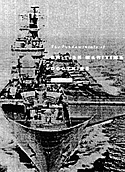Book Review
The Fundamentals of British Maritime Doctrine, Directorate of Naval Staff Duties, HMSO, 1996, ISBN 0 11 772470, 9.50£
Reviewed by David Manley
This is a very rare kind of book - written by military experts on how and, more importantly, why their particular part of the military - in this case the Royal Navy- do their business. It is intended primarily for serving naval personnel, in particular young officers joining the Britannia Royal Naval College (BRNC) at Dartmouth. Its secondary purpose is to act as a useful reference tool for academics and the media and aims to enhance the general appreciation of the readership for the contribution of maritime power to defence, national and international security.

The book runs through all the important aspects of governing and governed by the Royal Navy's maritime doctrine. Sections include an overview of the current defence climate and organizations within which the RN operates, discussions on the principles and theories of war, the application of maritime power, operational planning, command and control and logistics. As each point is made an illustrative example is included to show how that particular aspect had been dealt with in a real historical situation. For example, freedom of navigation is illustrated by the cruise of the carrier Victorious through Sunda Strait during the Indonesian Confrontation, the use of the Navy to support diplomatic objectives by the role of the RN during the Spanish Civil War, the pitfalls of ill-conceived operations by the experience of Gallipoli, and the need for a commander to recognize the limitations of current doctrine and to develop their own by the example of Nelson at Trafalgar. Of course the lessons learnt from the Navy's three major operations of the last 20 years - the Falklands, the Gulf War and Bosnia - are covered, as are less well known events such as the evacuation of foreign nations from the beaches of Aden by the Royal Yacht Britannia.
Since the book is written with the serving officer and academic in mind, one would expect a very dry technical writing style, but this is not the case. The authors have obviously taken great care to ensure that their final work, whilst achieving its aim of informing the expert, is appealing to those with a less professional (dare I say amateur) interest.
The book is concluded with a brace of appendices, the first discussing the Principles of War in greater depth, the second looking at the Falklands War from the doctrinal viewpoint, a glossary describing both the acronyms used in the book, such as CJTF, CPX, OOTW, and MPP, and the concepts embodied by the current "in vogue" buzzwords and buzz-phrases, such as "Battlespace", "Containment by Distraction" and "Vertical Escalation" (PS: no clues, if you want to know what they mean, buy the book'). The glossary itself includes many concepts applicable to current general military thinking, not just those applicable to the maritime area of operations.
This is a book which all budding modern naval experts should get their hands on and is freely availaLk through the HMSO Publications Centre, PO Box 276, London, SW8 5DT, tel. 0171-873-9090. David Manley is a naval architect working in the design and support offices of the Royal Navy. He has published a couple set of miniatures rules; Fox Two (modern air combat) and Action Stations (coastal forces). BT
Back to The Naval SITREP No. 9 Table of Contents
Back to The Naval SITREP List of Issues
Back to Master Magazine List
© Copyright 1996 by Clash of Arms.
This article appears in MagWeb (Magazine Web) on the Internet World Wide Web.
Other military history articles and gaming articles are available at http://www.magweb.com